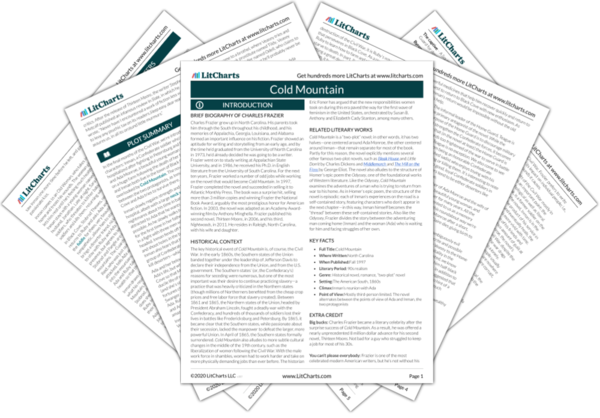Brief Biography of Charles Frazier
Charles Frazier grew up in North Carolina. His parents took him through the South throughout his childhood, and his memories of Appalachia, Georgia, Louisiana, and Alabama formed an important influence on his fiction. Frazier showed an aptitude for writing and storytelling from an early age, and by the time he’d graduated from the University of North Carolina in 1973, he’d already decided he was going to be a writer. Frazier went on to study writing at Appalachian State University, and in 1986, he received his Ph.D. in English literature from the University of South Carolina. For the next ten years, Frazier worked a number of odd jobs while working on the novel that would become Cold Mountain. In 1997, Frazier completed the novel and succeeded in selling it to Atlantic Monthly Press. The book was a surprise hit, selling more than 3 million copies and winning Frazier the National Book Award, arguably the most prestigious honor for American fiction. In 2003, the novel was adapted as an Academy Award-winning film by Anthony Minghella. Frazier published his second novel, Thirteen Moons, in 2006, and his third, Nightwoods, in 2011. He resides in Raleigh, North Carolina, with his wife and daughter.
Historical Context of Cold Mountain
The key historical event of Cold Mountain is, of course, the Civil War. In the early 1860s, the Southern states of the Union banded together under the leadership of Jefferson Davis to declare their independence from the Union, and from the U.S. government. The Southern states’ (or, the Confederacy’s) reasons for seceding were numerous, but one of the most important was their desire to continue practicing slavery—a practice that was heavily criticized in the Northern states (though millions of Northerners benefited from the cheap crop prices and free labor force that slavery created). Between 1861 and 1865, the Northern states of the Union, headed by President Abraham Lincoln, fought a deadly war with the Confederacy, and hundreds of thousands of soldiers lost their lives in battles like Fredericksburg and Petersburg. By 1865, it became clear that the Southern states, while passionate about their secession, lacked the manpower to defeat the larger, more powerful Union. In April of 1865, the Southern states formally surrendered. Cold Mountain also alludes to more subtle cultural changes in the middle of the 19th century, such as the liberalization of women following the Civil War. With the male work force in shambles, women had to work harder and take on more physically demanding jobs than ever before. The historian Eric Foner has argued that the new responsibilities women took on during this era paved the way for the first wave of feminism in the United States, orchestrated by Susan B. Anthony and Elizabeth Cady Stanton, among many others.
Other Books Related to Cold Mountain
Cold Mountain is a “two-plot” novel; in other words, it has two halves—one centered around Ada Monroe, the other centered around Inman—that remain separate for most of the book. Partly for this reason, the novel explicitly mentions several other famous two-plot novels, such as
Bleak House and
Little Dorrit by Charles Dickens and
Middlemarch and
The Mill on the Floss by George Eliot. The novel also alludes to the structure of Homer’s epic poem the
Odyssey, one of the foundational works of Western literature. Like the
Odyssey,
Cold Mountain examines the adventures of a man who is trying to return from war to his home. As in Homer’s epic poem, the structure of the novel is episodic: each of Inman’s experiences on the road is a self-contained story, featuring characters who don’t appear in the next chapter—in this way, Inman himself becomes the “thread” between these self-contained stories. Also like the
Odyssey, Frazier divides the story between the adventuring man coming home (Inman) and the woman (Ada) who is waiting for him and facing struggles of her own.
Key Facts about Cold Mountain
-
Full Title:Cold Mountain
-
Where Written:North Carolina
-
When Published:Fall 1997
-
Literary Period: 90s realism
-
Genre: Historical novel, romance, “two-plot” novel
-
Setting:The American South, 1860s
-
Climax:Inman’s reunion with Ada
-
Point of View:Mostly third-person limited. The novel alternates between the points of view of Ada and Inman, the two protagonists
Extra Credit for Cold Mountain













